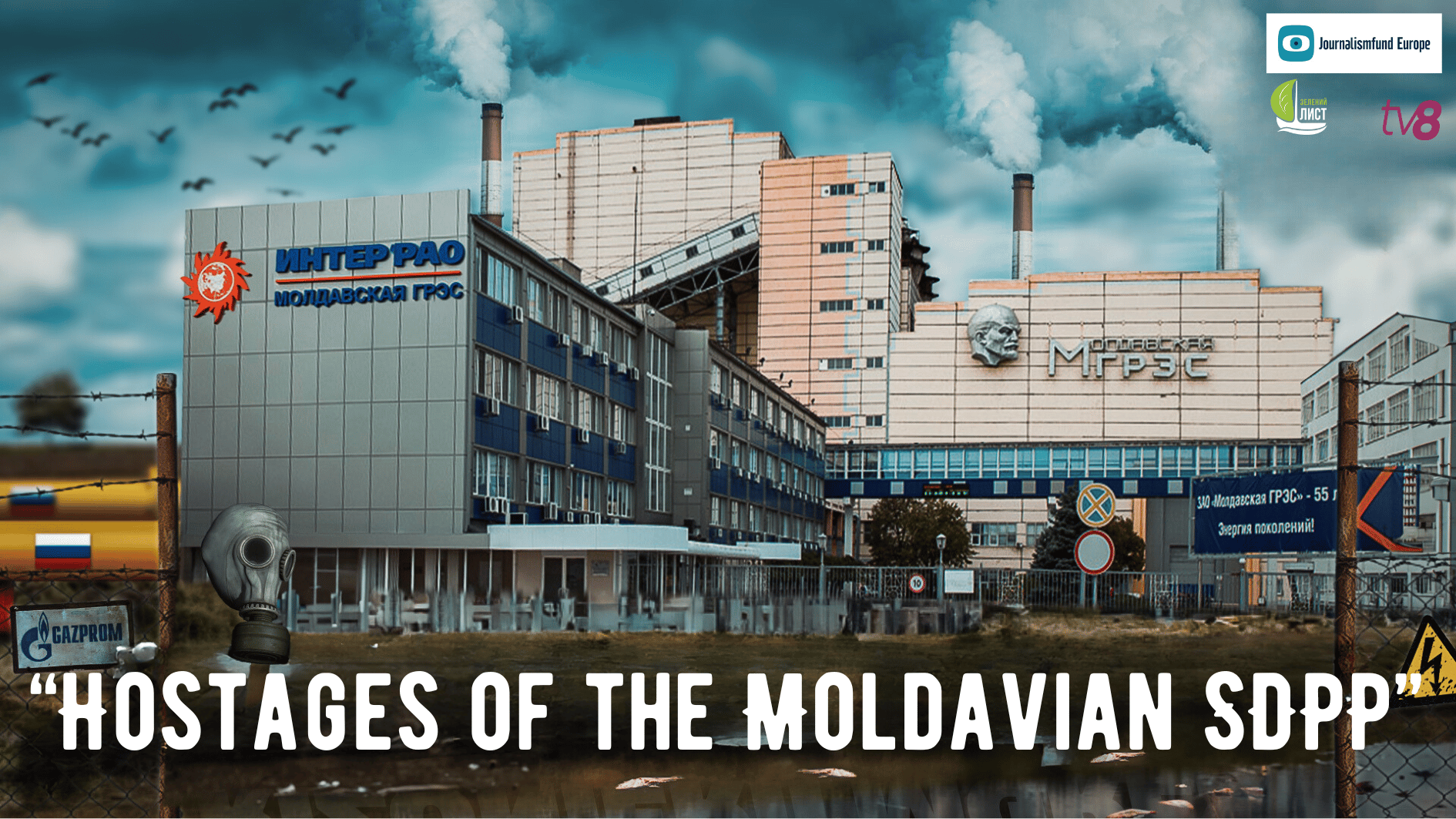Thermal power stations frequently contribute to pollution in the environment. According to scientists, outdated production methods, low-quality fuel, and insufficient environmental protection measures all have a significant negative influence on the environment.
The Moldavian Thermal Power Plant is in operation in the so-called Transnistrian Moldavian Republic, which is the portion of Moldova that Russia has occupied since 1992.
Together with their TV8 colleagues from Moldova, journalists from the Green Leaf NGO examined the effects of the operation.
Environmental issues
In 1964, the plant was constructed. It has a capacity of 2,520 megawatts, of which 1,700 megawatts are available. Coal, natural gas, and fuel oil are all viable fuel sources for Moldavian SDPP. The plant seriously harms the environment because of its antiquated machinery.
Between 2015 and 2021, MSDPP released roughly 3,000 kg of carbon dioxide into the atmosphere, according to the Moldavian Ministry of Environment. For comparison, over the same time period, the largest thermal power plant in the Moldova-controlled region released six times less carbon dioxide.
Additionally, Ukraine faces serious environmental and man-made threats as a result of the MSDPP. These include the possibility of the cooling pond and leftover waste from the Transnistrian thermal power plant flooding Ukrainian villages.
Svitlana Slesarenok has been working on the region since the early 2000s. She notes: “The Kuchurganske reservoir was built exclusively for the needs of the Moldavian SDPP.
The reservoir is artificially maintained for water intake and cooling of the thermal power plant at a level of up to 3.5 metres. MSDPP uses water from the Dniester, Turunchuk and Kuchurgan rivers. The Ukrainian villages of Kuchurgan and Lymanske are located below the reservoir level. The process is continuous: without filling the reservoir, the cooling of the MSDPP will stop, which threatens a man-made disaster. At the same time, if the pumping station does not operate to regulate the reservoir’s water level, the villages around the Kuchurhanske reservoir are at risk of flooding.
The threat of flooding exists for 380 households in the village of Kuchurhan, which is about a third of the total number, and more than 100 households in Lymanske.
“There are environmental problems, man-made problems, financial problems, and problems with the incidence of diseases. This reservoir was created for the economic activities of Moldavian SDPP. A system of protective structures was created to prevent the threat of flooding. It was 1967,” explains Larysa Gusak, deputy head of the Lyman village council (Ukraine).
MSDPP refuses to maintain drainage system
As the head of the Black Sea Women’s Club (Ukraine), Svitlana Slesarenok, explains, local communities bear the full financial burden of drainage system maintenance because MSDPP representatives are currently refusing to do so:
“The Moldavian SDPP used to maintain the system, provide free electricity, and run pumps that prevented people from drowning until 1999. Since then, the station no longer performs these functions. Consequently, local communities have to spend money on water pumping to guarantee the smooth operation of the Moldavian power plant. Right now, the entire system is in a state of emergency. And we cannot predict the potential environmental consequences.”
The community budget in Ukraine pays for the entire cost of the Moldavian SDPP’s pumping and drainage system. This includes salaries, ongoing repairs, regular maintenance, and the electricity required to operate the plant. The community has already spent 6.8 million hryvnias from their local budget since 2004 for this purpose alone. Currently, the amount is over 170 thousand pounds. However, the actual sum is significantly greater due to fluctuations in the exchange rate during the last two decades.
“We, as a community, do not gain anything from the Transnistrian Republic’s economic activities, specifically the production of electricity. Our community does not receive any benefits from this. We only receive compensation for our losses,” Larysa Gusak explains.
MSDPP makes money
Throughout the time when Ukrainian communities were paying for the expenses of running the Transnistrian power plant, the Russian firm MSDPP, registered in Chisinau, shipped electricity to the European Union.
Between 2007 and 2013, MSDPP marketed the electricity on the European Union marketplace, as stated by the Customs Service of the Republic of Moldova. The Customs Service of the Republic of Moldova declined to reveal the worth of the exports, indicating that this is private information.
The pumps run for 8 to 12 hours on average, contingent on canal fullness and weather. A pump empties 2600 cubic meters per hour, and one electric motor consumes 55 kilowatts of electricity. It’s hard for our village council to manage the electricity consumed during the 12-hour operation. “The village elder of Kuchurhan, Anatoliy Levytskyi, explained that we spent a third of our budget on maintaining the pumping station.”
Anatolii Levytskyi stated that the pumps were last fixed in 2016 and 2019, respectively, and typically last for 5-7 years after repair. There are four pumps in total, and they may become faulty soon. Moreover, there is a difficulty as the pumps are made in Russia, and they are not accessible in Ukraine. It is uncertain what to use instead of them and, most significantly, how much it will cost.
Moldavian SDPP objects to joining in repairs and technical aid. “They refuse to sign any agreements. Several commissions have met regarding the Moldavian SDPP, attended by representatives from Moldova, Transnistria, and Ukraine. However, the Transnistrian representatives did not sign any agreements. We provide maintenance, water pumping, and financial support for Moldavian SDPP’s technological cycle, while they profit from it.”
MSDPP declined to comment
Reporters requested comments from the MSDPP management regarding environmental issues in Kuchurgan and Lymanske villages. The press office confirmed receipt of the request, replied initially, then ceased communication.
We used to work on coal
According to the head of the village of Kuchurhan, until 2020, the MSDPP was operating on one of the dirtiest fuels, coal.
It is noteworthy that the power station received coal from the Russian Federation, and possibly from the occupied Donbass, through the territory of Ukraine. At the time, Russia’s aggression against Ukraine was already underway. According to the Moldova customs service, the MSDPP imported coal into Transnistria from January 2020 to October 2022.
“When the wind was strong, blowing from there, there was a bit of burning and smoke. It was just, you know, like there was a taste of this smoke and burning in the air,” says Anatolii Levitskyi.
Those responsible for monitoring carbon dioxide in the atmosphere calculate MSDPP emissions depending on the fuel used and its quality.
“Each megawatt-hour generated by natural gas emits 0.202 megatonnes of carbon dioxide. Based on this ratio, we calculate the carbon dioxide emissions of the power plant in question. If they are coal-fired, the coal quota is taken into account. Coal has a different emission factor. So we calculate how much gas and how much coal, and we get the amount of carbon dioxide emissions. It is worth noting that the efficiency of the power plant is less than 30%. This means that if one cubic metre of gas contains 10 kilowatt hours, we use less than 3 kilowatt hours and emit seven into the air. This efficiency is in line with the plant,” says Mihai Tirşu, director of the Energy Institute of Moldova.
Control is needed, but separatists refuse
According to Ion Bulmaga, head of Moldova’s Environmental Protection Inspectorate, monitoring is needed to identify all environmental problems. However, for political reasons, the inspectorate’s staff cannot enter the territory.
“We have discussed this issue. But the solution to this problem should be at a much higher level. And here we are talking about the 5+2 negotiating format, which will allow us to gain access and form joint inspection groups. But because of what is happening at the border, we know that this format is no longer viable. As a result, we cannot carry out inspections and express our position in accordance with the legislation of the Republic of Moldova,” said Ion Bulmaga, Head of the Environmental Protection Inspectorate of the Republic of Moldova.
Ion Bulmaga noted that Tiraspol has a peculiar approach to environmental compliance. “If the unrecognised regime in Tiraspol requires permits for some companies to export to the European Union, they allow the inspection. If they do not need to export to the EU market, but only to Moldova, they deny access to inspectors for inspections.
They refuse to clean the Kuchurgan reservoir
For the past 20 years, the plant’s management has not replaced the water in the reservoir, causing its quality to deteriorate significantly.
Residents of Kuchurhan village recall that the reservoir used to be home to crayfish and lilies. Today, algae bloom and fish die off on a regular basis. These testimonies are confirmed by experts from the Ukrainian State Ecological Inspectorate. An inspection of the reservoir in 2017 showed that the standards for chlorides, sulphates and dry residue were exceeded.
“When they wash their reactors, there is a lot of alkaline water. We had a pumping station in the village of Kuchurhan that pumped water from the estuary for irrigation. After irrigation, the ground was white with these salts,” recalls Anatolii Levytskyi.
In addition to the problem with the Kuchurhan reservoir, the Moldavian SDPP also created another problem for Ukraine. For many years, employees of the Transnistrian thermal power plant dumped toxic waste on land near the Ukrainian village of Hradenitsy.
Problems with the slag dump
The slag dump, located on the territory of Ukraine, covers an area of approximately 130 hectares. The community cannot use this contaminated land until the hazardous materials have been removed and the area reclaimed.
Today, the slag dump is covered with grass, so the dangerous dust is not concentrated in the air. For a long time, however, the dump was a constant threat to the lives and health of the people of Hradenytsi. When the wind blew from the landfill, black dust filled the air.
By 2003, doctors were noticing an increase in the incidence of cancer among local residents. And for several decades, the problem remained unresolved. Now the situation has been complicated by a full-scale war.
“The problem exists. It has been there for probably 30 years. The people in our village are at risk of cancer. There is a dump on our land. There is no access to it now. But the slag is a problem for the inhabitants of our village,” says Oleksandr Savchuk, head of the village of Hradenytsi (Ukraine).
At the same time, Svitlana Slesarenok believes that the problem needs to be solved on a legal level:
“This is a legal entity. And if we fail to solve this problem again, we will have to go to the legal level. There are documents that show how much the local communities have spent during this time.
Under the control of russia
The legal registration of the Transnistrian MSDPP in the Republic of Moldova is a sensitive issue, as Chisinau does not recognise state enterprises privatised in the so-called Transnistrian region after 1991.
In 2005, the Russian giant Inter RAO UES acquired 51% of MSDPP shares. The company is currently chaired by Boris Kovalchuk, the son of Russian President Vladimir Putin’s closest ally.
A number of countries have imposed sanctions on Kovalchuk for supporting Russia’s war against Ukraine. They include the UK, the US, Canada, EU countries and others.
“As for the Kuchurgan Thermal Power Plant (MSDPP – ed.), contrary to popular belief, the Republic of Moldova has not recognised the privatisation of this enterprise. The status of the economic agent with whom you cooperate is one thing, but the status of the privatisation of this enterprise, as well as other enterprises, is another. We have not recognised the privatisation of any enterprise in the Transnistrian region that existed during the Soviet period. That is why we make a very clear distinction between newly created enterprises after 1991, mostly small and medium-sized enterprises, and privatised enterprises, as I mentioned earlier, which were illegally appropriated after 1991,” says Oleg Serebrian, Deputy Prime Minister for Reintegration of the Republic of Moldova.
The fate of MSDPP must be decided
Oleg Rubel, a researcher at the National Academy of Sciences of Ukraine, stresses that the environmental problems caused by the MSDPP cannot be considered in isolation from the political problems of Transnistria. The situation is complicated by the fact that the problems of the Moldovan power plant are cross-border and affect the interests of several countries – Ukraine, Moldova and the Russian Federation.
Both Ukraine and Moldova have declared their intention to join the European Union and have committed themselves to addressing environmental issues. The Moldavian SDPP is already so technically obsolete that the question of its closure or in-depth modernisation is being raised. It is now important to set up a monitoring station that meets European requirements in order to obtain accurate and reliable information on the environmental impact of the Moldavian SDPP.
“This power system that we see today certainly does not meet modern requirements in terms of technological approaches, technical approaches and does not meet any environmental and political requirements for development. I think we need to assess very carefully what resources this plant can still work with. Several options for its re-profiling should be proposed,” said Rubel.
At the same time, according to the director of the Energy Institute of Moldova, Mihai Tirsu, the MSDPP currently plays a key role in the country’s energy infrastructure:
“Let’s say they close the power plant. Where are we going to get electricity from? We are in a situation where we cannot function without it. Besides, our energy system is very closely connected to Ukraine through Transnistria.
Hooked
In summer, MSDPP produces about 90-95% of Moldova’s electricity needs. In the winter, due to the operation of CHP plants on the territory controlled by Chisinau, electricity purchases from MDRES fall to 65-70%.
Until autumn 2022, the Moldavian state-owned company Energocom purchased 67% of the required electricity from MDRES. The remaining 30% was purchased from Ukrainian producers. Energoatom and Ukrhydroenergo. Everything changed in October 2022, when Russia began bombing Ukraine’s energy infrastructure.
“There was a shortage of energy in Ukraine. As a result, Ukrainian companies informed us that they could not meet their obligations. At that time, we started buying from Romanian producers because the electricity systems of Moldova and Romania were synchronised,” says Evgeny Bots, head of the supply department at Energocom (Moldova).
The only electricity import line from Romania to Moldova is the MDRES – Isaccha-Vulcenesti-Chisinau. On 15 and 23 November 2022, after the Russian bombing of the Odesa region, this line went down, leaving Moldova in the dark.
“If something happens on the MDRES, the line will be cut, the Republic of Moldova will be left without electricity, exactly what happened in November when Ukraine’s energy infrastructure was bombed. And we had two blackouts: one partial and one complete,” stresses Yevgeny Bots.
Does Moldova support MSDPP?
The Republic of Moldova pays about $20 million a month to the Moldavian SDPP for the electricity it consumes.
“Now we have a contract until the end of September at a price of $66 per megawatt hour. We set the volumes they supply us with MoldGres on a monthly basis, usually between 300,000 and 320,000 megawatt-hours. So, multiplied by the price of EUR 60, it comes to almost EUR 18-20 million per month,” notes Yevgeny Bots.
The MSDPP does not pay Moldovagaz for the fuel it consumes. This is how the system works: The MSDPP pays Tiraspoltransgaz-Transnistria for the gas, and Tiraspol transfers the money to a special account opened at the Central Bank of the Transnistrian region.
The money is then transferred to the budget of the separatist regime in Tiraspol. As of mid-August this year, Tiraspoltransgaz’s debt to Moldova was around $10 billion.
Moldova is a participant in the system through which Gazprom finances the existence of the pro-Russian separatist region. At the same time, the cost of electricity for Moldova is almost 50% lower than the market price:
“We buy electricity from Moldavian SDPP at about 50% less than prices in the region. So if we go to Romanian producers, it’s at least 90 euros. And when we go to the stock exchange because the producers cannot give us the amount we need, the price is between 100 and 300 euros, depending on the regional situation,” says Yevhen Bots.
He plans to get rid of his addiction
In a bid to end its energy dependence on Transnistria, Chisinau has begun construction of the Vulcenesti-Chisinau direct line, which will shut down the Moldavian SDPP. According to the project, the construction should be completed in 2025.
“The deadline of 2025, mid-2025, is realistic because we have been negotiating very hard with the contractor in recent months to commit both them and ourselves to this deadline,” explains Ruslan Suruzhiu, Director of the Consolidated Unit for the Implementation and Monitoring of Energy Projects (Moldova).
However, much remains to be done to solve the environmental problems in Ukraine and the occupied territory of Moldova through the activities of the MSDPP.

The material was created with the support of Journalismfund Europe.

